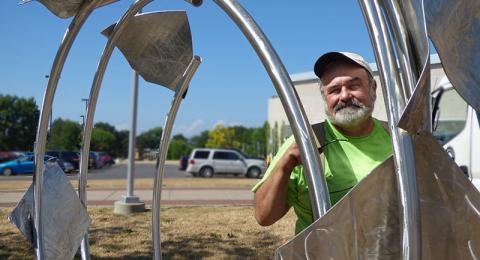New sculptures sprout in college's second exhibition of public art
Office of Communications and Marketing
Published
SUNY Oswego’s sculpture garden now blooms with bright red spikes and other eye-catching pieces in the second biennial Oswego Sculpture Initiative between Marano Campus Center and Penfield Library.
The display showcases the work of six artists from as far away as North Carolina and as near as Rochester.
One piece remains from the 2014-16 inaugural exhibition: “Campanile (Bell Tower).” Artist Edward Kelley of Drake University in Des Moines donated his work to the college, according to Tyler Art Gallery Director Michael Flanagan and art faculty member Benjamin Entner, co-founders of the Oswego Sculpture Initiative. Ultimately, Drake’s piece will stand near the south entrance of the Richard S. Shineman Center for Science, Engineering and Innovation.
The new exhibition features sculptures by Jim Gallucci of Greensboro, North Carolina; miChelle Vara of Wilton, who also had a piece in the first show; Frederick Douglass Schatz of Potsdam; Cathy Perry of Chocowinity, North Carolina; and Kevin Dartt and Duncan Chase, both of Rochester.
Entner, who also founded the fiery iron pour demonstration each autumn, said the teaching-and-learning value of public art for campus and the greater community is significant. “I have enjoyed eavesdropping on faculty, staff and students while they remark, both good and bad, on the sculptures,” he said. “I think both good and bad comments are positive—people are now talking about art on campus and it has become something they expect and want.”
Student artists benefit, Entner said, because they can see works by sculptors making a living at their art, explore firsthand their media and methods, and even take part in the process of assembling the exhibition. “This time around a few students were able to be more intimately involved in the process,” he said.
New pieces
Nearly all the new sculptures are in place. Gallucci, for example, installed “Divine Wind II” on a hot day in late July. The circular swirls of stainless steel tubing on a weathering steel base evoke a gateway or door to give visitors “entry” into his art and to heighten our awareness of art in public spaces, he said.
“Divine Wind II” is part of a series, said Gallucci, who earned fine arts degrees at Le Moyne College and Syracuse University. In an artist’s statement, he wrote that art “evokes a chord deep within us. Good art challenges us, can make us feel righteous, move us, soothe us, heal us and bring us peace.”
The piece Gallucci originally planned for SUNY Oswego was installed in Orlando earlier this summer, a few days after the June 12 massacre in the Pulse nightclub. “We just saw a whole city of hurt, but we hope we gave them some hope, too,” he said. “Mine is an art piece about that whole day, about great sorrow and giving and hope.”
Other pieces installed for the latest two-year run include:
* Vara’s “Industrial Nation,” which features steel H beams and a farm implement wheel, a remembrance of lives lost during 9/11. The artist wrote that one beam is angled “to signify the rise of human interaction, care, relationships, opportunities, change and the horizon, and the other standing straight to portray this country’s unified strength against obstacles. The wheel and hub holds all components together while the cogs grab, moving forward in a representation of all rescue and military forces working together.”
* Dartt’s “Under the Wave,” an interactive wood, steel and acrylic sculpture that he said “stands as a cautionary tale of what may happen as the elements of our synthetically driven lifestyle meet the natural environment. It evokes a sense of peril from the water or, more specifically, from dangerously polluted waters.”
* Schatz’s “Prince,” a welded steel gathering of outsized triangular spikes that appear to rise from the earth, “arranged in a circular pattern and individually bolted to a substrate, illustrating (Schatz’s) belief that while we are an integral part of the earth and its environment, we seek to separate ourselves from it as well,” the artist wrote.
* Perry’s “The Tall Thin Woman,” a cast aluminum piece representing a farm woman standing in a flower garden. The artist, who explores themes of families entwined and interwoven for survival, noted: “The braid of her hair and the lines of her skirt flow back to show the blowing Kentucky wind. The figure holds a flower freshly cut from her garden.”
* Chase’s “Arc #2,” a sculptural composition of cast bronze, iron cedar, sheet copper, zinc, brass, mild steel and welded steel. The artist, whose work investigates the point at which the human and animal worlds collide, wrote: “The nautical forms and gestures in this sculpture initially boast strength and protection but when occupied will reflect warmth, safety, compassion and a bustling community. The artist hopes this sculpture will serve as a safe haven for local wildlife and draw attention to our important symbiotic relationship.”



